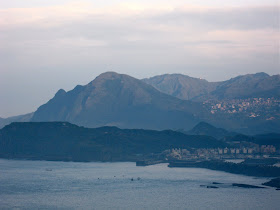
I'll probably blog a lot today because I have no voice, can't work if I can't talk, but am fine on energy!
Joseph has already covered the basics on how to get there and what to see, so I'll focus this post mostly on photos. Heping Island has two main things to see: a seaside area with cliffs and odd rock formations reminiscent of Yehliu.
Our initial impression was disappointing - the main entrance to the park is under construction and you have to walk through it to get to the seafront, which was cool and grey, and not particularly attractive. The walk to the construction site entrance is lined with murals which are spattered with graffiti:

Clearly this guy doesn't have much experience with 奶奶.
There were some snorkelers about. They were clearly insane.

Wandering a little farther along, being careful not to slip on increasingly treacherous rock, we came upon the Yehliu-esque area.
It was nice, and had some cool stuff going on, including lots of fishermen and snorkelers playing about the edges, but other than being quieter and less built-up than Yehliu, it was basically a smaller version of...well...Yehliu.


We then hopped on an old cannister to scale the fence to the "closed off" trail around the cliff that everyone was still using. The view got better from here, looking down over an odd old cement pagoda and an expanse of striated rock.

Across the way we could see two caves - one of which was an actual cave and the other just a dark crevice. The cave had a man-made entrance plopped down in front:

...and is called the "Cave of Foreign Words" - inside is dated graffiti in a number of languages. Apparently there are old Dutch and Portuguese carvings in the rock, but the oldest dates we could see were from the 1870s.
Don't worry about the "Military Activity Site" warning - it's old and no longer enforced. You can go in. Bring a good flashlight.
Back across the rock are two shrines underneath the pagoda, one appreciably larger than the other. Both are built of and around natural rock formations for 石頭公 - rock spirits. One was decorated with Buddhist and folk Daoist icons with a red-painted rock, and plastic and paper cartoon rabbits adorned the sides, presumably in celebration of Year of the Rabbit.

A rock spirit.

The smaller of the two shrines.

The incense urn, cemented to the rock, of the larger shrine (the first rock spirit is above it).

The red rock in the shrine.

Outside the shrine we came across these faded words once painted in gold. "Xin" was the only one we could decipher.
We also discovered what appears to be coral - please correct me if I'm wrong on that. It sure looks like coral and is the right color, but aren't we too far north for that? Wouldn't the water be too cold? Maybe the snorkelers knew a thing or two after all...?

After exiting the park back through the construction and past a random karaoke bar, we stopped for lunch, which was good despite the fish-mash rabbit in my soup:

We passed one of the oldest preserved structures in northern Taiwan. Not far from the bridge to Heping Island is a well used by the Dutch in the 1600s that is still in use today:


...as you can see, despite its age and impressive history it's not that exciting to look at.
We then walked to a fort (I forget the name) built at the turn of the 20th century by the Japanese. To get there, you walk back towards Heping Bridge then hang a left at the seafood market. Keep going until you reach a little fallow area and then turn up the hill. Keep going and turn up another, steeper hill to the right, which leads through a very poor aboriginal area (I hesitate to say "slum" but that's what it is). Yes, there's a lot of poverty here and it shows a side of life in Taiwan that most foreigners never see, and don't care to see, but it is safe. People sitting outside chatting (not sure of the tribe and therefore the language, but my best guess would be Amis) greeted us warmly.
The first part of the fort is at the top of the village hill, and is not very impressive (really, it's just an old house structure without a roof). If you go a little further up, you reach some more stone fortifications, which are mildly more interesting and you can poke around inside.
Keep heading up, and it gets more interesting still: old brick and stone fortifications in a distinctively early 20th-century style with more extensive poking around (it's muddy and full of bugs, so if you, like a certain infamous Canadian woman, freak out about insects, you may not want to go inside).
Climbing the stairs to the top of this set of fortifications, you reach the top of the hill and get a gorgeous view. On one side, a stretch of ocean.
Ahead of you, Keelung Island.
To the right, a view of Jiufen, Jinguashi and Keelung Mountain and beyond that, the Bitou cliff peninsula.
We wrapped up as twilight was setting in and headed down to get coffee before going to the Miaokou Street night market - we weren't hungry enough to tackle it yet. As we chilled out in Cat's Cafe (right at the base of the road that heads up to the giant Guanyin and Ghost Month temple), which used to be a straight-up coffeeshop but is now turns into something of a small lounge bar at night.
Of course, the night market is always a blast. We got cream crabs:







Looks really similar to Bitou Cape actually. Except for the awesome view of Keelung island. What's the deal with Keelung and Hoping island? Are they the same island?
ReplyDelete